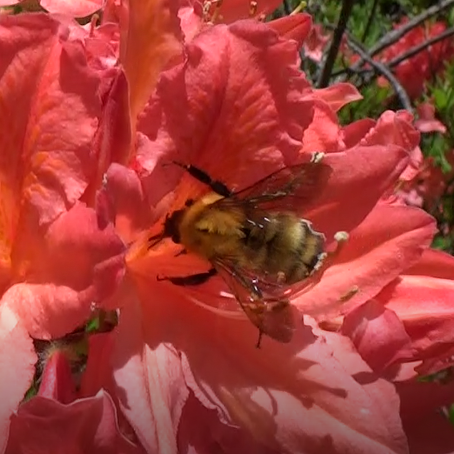Visitation frequencies of bumblebees and swallowtail butterflies to flowers and the nectar sugar concentration of Rhododendron kaempferi and R. japonicum in mountains of central Japan
DOI:
https://doi.org/10.26786/1920-7603(2017)438Abstract
Relationships between flower visitor composition and floral traits help us to understand floral evolution. Swallowtail butterflies have been assumed to be the main pollinators of Rhododendron kaempferi and R. japonicum based on their floral shapes, and R. kaempferi was reported to be pollinated by butterflies in southern Japan. In the mountains of central and northern Japan, however, bumblebees are abundant and candidate pollinators of Rhododendron. We found that visitation frequencies of bumblebees were higher than those of swallowtail butterflies to both of the Rhododendron species at three study sites in the mountains of central Japan. R. japonicum pollen adhered to the bodies of both floral visitors. Further, the nectar sugar concentration of R. kaempferi was in the preference range of bumblebees, whereas that of R. japonicum was suited to both bumblebees and butterflies. Taken together, these findings support the hypothesis that bumblebees are potentially also important pollinators of R. kaempferi and R. japonicum in mountains of central Japan, where they are more abundant than swallowtail butterflies.
References
Chwil M, Weryszko-Chmielewska E (2009) Characteristics of nectaries and nectar in flowers of two Rhododendron species. Journal of Apicultural Science 53: 17-27.
Cruden RW, Hermann-Parker SM (1979) Butterfly pollination of Caesalpinia pulcherrima, with observations on a psychophilous syndrome. The Journal of Ecology 67: 155-168. DOI: https://doi.org/10.2307/2259342
Epps MJ, Allison SE, Wolfe LM (2015) Reproduction in flame azalea (Rhododendron calendulaceum, Ericaceae): A rare case of insect wing Pollination. The American Naturalist 186: 294-301. DOI: https://doi.org/10.1086/682006
Escaravage N, Wagner J (2004) Pollination effectiveness and pollen dispersal in a Rhododendron ferrugineum (Ericaceae) population. Plant Biology 6: 606-615. DOI: https://doi.org/10.1055/s-2004-821143
Fenster CB, Armbruster WS, Wilson P, Dudash MR, Thomson JD (2004) Pollination syndromes and floral specialization. Annual Review of Ecology, Evolution, and Systematics: 375-403. DOI: https://doi.org/10.1146/annurev.ecolsys.34.011802.132347
Georgian E, Fang Z, Emshwiller E, Pidgeon A (2015) The pollination ecology of Rhododendron floccigerum Franchet (Ericaceae) in Weixi, Yunnan Province, China. Journal of Pollination Ecology 16: 72-81. DOI: https://doi.org/10.26786/1920-7603(2015)11
Goulson D (2003) Bumblebees: their behaviour and ecology. Oxford University Press, New York.
Itino T, Kato M, Hotta M (1991) Pollination ecology of the two wild bananas, Musa acuminata subsp. halabanensis and M. salaccensis: chiropterophily and ornithophily. Biotropica 23: 151-158. DOI: https://doi.org/10.2307/2388300
Johnson SD, Steiner KE (2000) Generalization versus specialization in plant pollination systems. Trends in Ecology & Evolution 15: 140-143. DOI: https://doi.org/10.1016/S0169-5347(99)01811-X
Kevan PG, Baker HG (1983) Insects as flower visitors and pollinators. Annual Review of Entomology 28: 407-453. DOI: https://doi.org/10.1146/annurev.en.28.010183.002203
Kiritani K (2006) Predicting impacts of global warming on population dynamics and distribution of arthropods in Japan. Population Ecology 48: 5-12. DOI: https://doi.org/10.1007/s10144-005-0225-0
Kudo G (1993) Relationship between flowering time and fruit set of the entomophilous alpine shrub, Rhododendron aureum (Ericaceae), inhabiting snow patches. American Journal of Botany 80: 1300-1304. DOI: https://doi.org/10.1002/j.1537-2197.1993.tb15368.x
Kudo G, Hirao AS, Kawai Y (2011) Pollination efficiency of bumblebee queens and workers in the alpine shrub Rhododendron aureum. International Journal of Plant Sciences 172: 70-77. DOI: https://doi.org/10.1086/657282
Kuriya S, Hattori M, Nagano Y, Itino T (2015) Altitudinal flower size variation correlates with local pollinator size in a bumblebee-pollinated herb, Prunella vulgaris L. (Lamiaceae). Journal of Evolutionary Biology 28: 1761-1769. DOI: https://doi.org/10.1111/jeb.12693
Mejias JA, Arroyo J, Ojeda F (2002) Reproductive ecology of Rhododendron ponticum (Ericaceae) in relict Mediterranean populations. Botanical Journal of the Linnean Society 140: 297-311. DOI: https://doi.org/10.1046/j.1095-8339.2002.00103.x
Nagano Y, Abe K, Kitazawa T, Hattori M, Hirao AS, Itino T (2014) Changes in pollinator fauna affect altitudinal variation of floral size in a bumblebee-pollinated herb. Ecology and Evolution 4: 3395-3407. DOI: https://doi.org/10.1002/ece3.1191
Ollerton J, Alarcón R, Waser NM, Price MV, Watts S, Cranmer L, Hingston A, Peter CI, Rotenberry J (2009) A global test of the pollination syndrome hypothesis. Annals of Botany 103: 1471-1480. DOI: https://doi.org/10.1093/aob/mcp031
R Core Team (2017) R: A language and environment for statistical computing. R Foundation for Statistical Computing, Vienna, Austria. URL https://www.R-project.org/.
Rosas-Guerrero V, Aguilar R, Martén-Rodríguez S, Ashworth L, Lopezaraiza-Mikel M, Bastida JM, Quesada M (2014) A quantitative review of pollination syndromes: do floral traits predict effective pollinators? Ecology Letters 17: 388-400. DOI: https://doi.org/10.1111/ele.12224
Schemske DW, Bradshaw HD (1999) Pollinator preference and the evolution of floral traits in monkeyflowers (Mimulus). Proceedings of the National Academy of Sciences 96: 11910-11915. DOI: https://doi.org/10.1073/pnas.96.21.11910
Stout JC, Parnell JA, Arroyo J, Crowe TP (2006) Pollination ecology and seed production of Rhododendron ponticum in native and exotic habitats. Biodiversity & Conservation 15: 755-777. DOI: https://doi.org/10.1007/s10531-004-1065-5
Tanaka H (1993) Introduction to floral ecology. Nouson Bunkasha, Tokyo. (In Japanese)
Tanaka H (1997) Ecology of flower-insect interactions. Hoikusha, Osaka. (In Japanese)
Tanaka H (2001) Mutual deception between flowers and insects. Kodansha, Tokyo. (In Japanese)
Vlašánková A, Padyšáková E, Bartoš M, Mengual X, Janečková P, Janeček Š (2017) The nectar spur is not only a simple specialization for long-proboscid pollinators. New Phytologist 215: 1574-1581. DOI: https://doi.org/10.1111/nph.14677
Willmer P (2011) Pollination and floral ecology. Princeton University Press, Princeton. DOI: https://doi.org/10.23943/princeton/9780691128610.001.0001
Yokogawa M, Hotta M (1995) Taxonomical notes on plants of southern Japan II. Variation in the Rhododendron obtusum group in the Kirishima Mts., southern Kyushu. Acta Phytotaxonomica et Geobotanica 46: 165-183.

Downloads
Published
How to Cite
Issue
Section
License
Copyright (c) 2017 Keigo Takahashi, Takao Itino

This work is licensed under a Creative Commons Attribution 4.0 International License.











